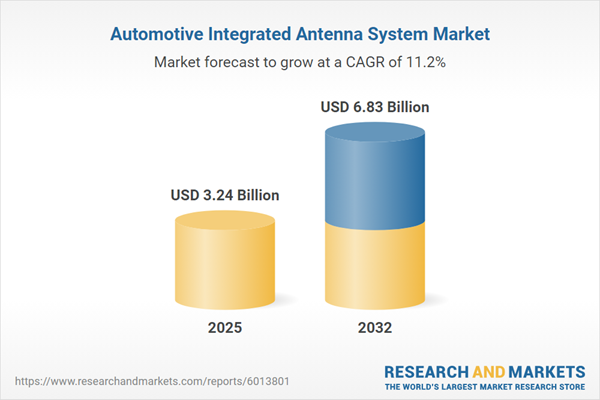Speak directly to the analyst to clarify any post sales queries you may have.
Automotive integrated antenna systems are transforming vehicle connectivity, offering sophisticated solutions to meet the evolving demands of passenger and commercial vehicles. As the automotive sector shifts toward connected platforms, decision-makers are challenged to select technologies that ensure operational efficiency, compliance, and future scalability.
Market Snapshot: Automotive Integrated Antenna System Market Insights
The global automotive integrated antenna system market is demonstrating robust momentum, currently valued at USD 2.92 billion. Growth is set to continue, reaching USD 3.24 billion by 2025 and USD 6.83 billion by 2032, supported by an 11.20% CAGR. Demand for high-performance in-vehicle communications and compliance-oriented solutions is encouraging significant investment from original equipment manufacturers, key suppliers, and fleet operators. As OEMs seek compact, multifunctional antenna technologies, the drive for optimized digital infrastructure and resilient systems is directly impacting procurement and R&D strategies across the mobility value chain.
Scope & Segmentation of the Automotive Integrated Antenna System Market
- Technology: Solutions integrate AM/FM radio, Bluetooth, GPS, 4G/5G cellular, satellite, and Wi-Fi antennas, supporting reliable infotainment, navigation, data management, and safety communications.
- Vehicle Types: Both passenger vehicles—including sedans, hatchbacks, SUVs, and coupes—and commercial vehicles are served, each with distinctive requirements for fleet analytics, operational efficiency, and connectivity performance.
- Installation Types: Embedded and retrofit antenna options enable both seamless integration into new manufacturing projects and the modernization of existing vehicle fleets.
- Antenna Styles: Mirror mount, roof mount, shark fin, and windshield-embedded designs allow manufacturers to deliver aerodynamic gains and stable signal performance while addressing styling preferences.
- Application Areas: Products enable digital radio, GPS navigation, telematics, emergency calling, and real-time vehicle tracking, prioritizing signal reliability and regulatory compliance in all operational environments.
- Regional Coverage: The Americas, Europe, Middle East & Africa, and Asia-Pacific represent core markets, shaped by distinct regulatory requirements, infrastructure investments, and customer preferences across regions.
- Company Leadership: Notable market participants include Continental Aktiengesellschaft, DENSO Corporation, Panasonic Corporation, Kathrein Werke KG, TE Connectivity Ltd., Harman International Industries, Valeo SA, Mitsubishi Electric Corporation, Sumitomo Electric Industries, and Murata Manufacturing Co., Ltd., each extending their reach through alliances and ongoing R&D commitment.
Key Takeaways for Senior Decision-Makers
- Integrated antenna systems enable efficient network management, supporting upgrades for both new and legacy fleets, and facilitating streamlined software-over-the-air functionalities.
- Varied global regulations in automotive connectivity demand agile operational frameworks and product models responsive to regional standards and market-specific guidelines.
- Modular platform features, including adaptive beamforming and customizable hardware, offer enhanced scalability, allowing for convenient system expansion and future-proofing vehicle platforms.
- Strengthening supplier diversification strategies improves adaptability and supply assurance, providing stability in evolving global trade conditions and procurement ecosystems.
- Regional variations in adoption rates, safety protocols, and digital infrastructure call for highly customized deployment approaches and regionally directed investments.
- Collaborative partnerships among OEMs, technology firms, and telecom providers are paramount to meeting complex connectivity expectations and maintaining vehicle competitiveness in dynamic markets.
Tariff Impact on Supply Chains and Cost Structures
Recent tariff adjustments in the United States have directly influenced sourcing and production strategies within the automotive integrated antenna system market, particularly for components sourced from Asia. Companies are responding by adopting nearshoring practices, utilizing bonded warehouse solutions, and renegotiating agreements with suppliers. These proactive measures help preserve cost structures, sustain inventory flow, and enhance supply chain resilience as market dynamics and policies evolve.
Methodology & Data Sources
Market insights are obtained from rigorous analysis of authenticated secondary sources and in-depth direct engagement with industry executives, supply chain specialists, and automotive engineers. All intelligence is cross-verified through triangulation and independent review, producing actionable input for automotive strategy formulation.
Why This Report Matters
- Empowers leadership with data-driven intelligence for guiding strategies around technology adoption, compliance requirements, and partnership development in the automotive connectivity sector.
- Facilitates robust benchmarking and planning for advanced integration of vehicle connectivity across variable regulatory environments and emerging market opportunities.
- Supplies actionable analytics to improve organizational responsiveness and protect investment decisions as connectivity solutions and customer expectations continue to develop.
Conclusion
Sustained focus on agile supply chains, cross-industry partnerships, and regulatory adaptability positions automotive organizations to compete successfully as advanced connectivity shapes future mobility trends.
Additional Product Information:
- Purchase of this report includes 1 year online access with quarterly updates.
- This report can be updated on request. Please contact our Customer Experience team using the Ask a Question widget on our website.
Table of Contents
3. Executive Summary
4. Market Overview
7. Cumulative Impact of Artificial Intelligence 2025
Companies Mentioned
The companies profiled in this Automotive Integrated Antenna System market report include:- Continental Aktiengesellschaft
- DENSO Corporation
- Panasonic Corporation
- Kathrein Werke KG
- TE Connectivity Ltd.
- Harman International Industries, Inc.
- Valeo SA
- Mitsubishi Electric Corporation
- Sumitomo Electric Industries, Ltd.
- Murata Manufacturing Co., Ltd.
Table Information
| Report Attribute | Details |
|---|---|
| No. of Pages | 191 |
| Published | November 2025 |
| Forecast Period | 2025 - 2032 |
| Estimated Market Value ( USD | $ 3.24 Billion |
| Forecasted Market Value ( USD | $ 6.83 Billion |
| Compound Annual Growth Rate | 11.2% |
| Regions Covered | Global |
| No. of Companies Mentioned | 11 |









